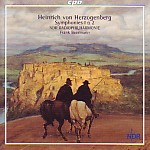There are Meisters, and there are “Kleinmeisters” (“minor masters”), and then there are “Überkleinmeisters” (“really minor masters”). Herzogenberg belongs to this last category. Like so many German symphonists of the mid- to late-19th century, his world was ruled by intimidation and fear: intimidation by the achievements of the past, and fear of using the orchestra for less noble, programmatic purposes. Of course, the most famous case of this kind of artistic insecurity was Brahms, but Brahms was a genius and geniuses always find their way out of a jam. Herzogenberg was no genius but was merely a competent composer who managed, after much soul-searching and angst, to squeeze out these two attractive symphonies in the mid- to late-1880s.
Make no mistake, they are attractive. The slow movement, and in particular that of the C minor symphony, are very beautiful and melodically memorable. Herzogenberg’s orchestration, cautious though it is, does not lack for color, and he knows how to write a development section, as both first movements attest. What the music lacks is drama on the one hand and humor on the other, though the B-flat symphony has plenty of charm. Humor, of course, is not exactly a German specialty in works of this type, but it does exist (consider Draeseke’s Second Symphony, for example). Still, Herzogenberg’s dogged earnestness can be trying, as in the far-too-long slow introduction for the C minor symphony’s opening movement.
When all is said and done, for all of their easy listenability these two works lack those distinctive touches that distinguish the good from the great. However, the performances sound very sympathetic: well played, sensibly paced, and flawlessly recorded. The orchestral strings understand the music’s Brahmsian style and offer plenty of warmth as well as excellent support for the woodwinds–and I know this sounds like damning with faint praise. The problem with the German “abstract” symphonic style lies in the fact that if a composer wants to subject himself to rigorous discipline in terms of form and orchestral color, he needs to compensate with a corresponding profundity of ideas and mastery of dramatic movement. Hezogenberg understands the problem but doesn’t quite have the solution. But he tries very hard, and very sincerely. For many collectors that may well be enough.
































